Those who visit the Egyptian galleries and see about them the imposing representations of the pharaohs which are displayed there-the large seated statue and sphinx of Ramses II, for example, or the reliefs of Merenptah’s massive gateway-may not be aware that the most remarkable portrayal of a king in our collection is a stone statuette only two inches long (fig. 11). What makes this statuette so unusual is its attitude; the king is prostrate, both legs extended behind him and both arms outstretched, palms downward. His head is completely vertical, its erectness lending to the little figure something of a sphinxlike dignity. Nonetheless, the king is undeniably in an attitude of utmost humility. One may well ask why, for even commoners are rarely represented in so complete an obeisance. And the king of Egypt was immeasurably above all others; he was the son of a god and was himself the god Horus.
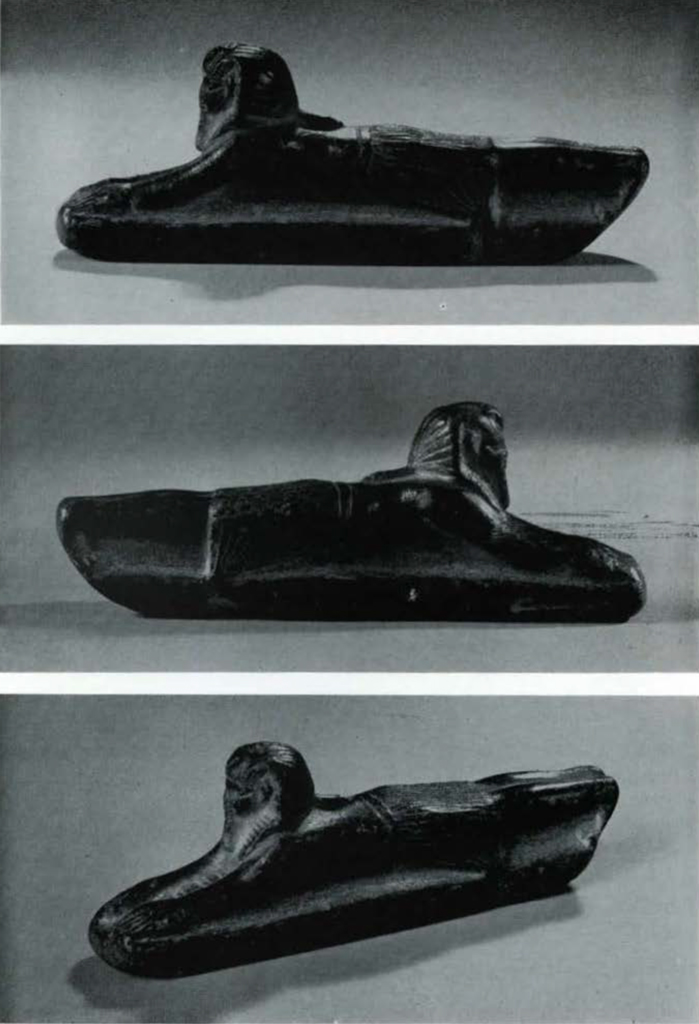
Museum Object Number: 48-16-1
Image Numbers: 61954, 61953, 61952

Museum Object Number: 48-16-1
Image Number: 61951
With this question before us, we may now consider the statuette itself more closely, as well as what is known of its origin. Nothing is recorded concerning the site and circumstances of its initial discovery. It was purchased by Miss Sophia Cadwalader at Blanchard’s shop in Cairo 49 years ago, and Miss Cadwalader, the donor of other rare objects in our collection, presented it to the University Museum in 1948. Its catalogue number is 48-16-1. The length of the statuette has already been noted as about two inches-5.6 centimeters, to be more exact. The material is steatite, a soft stone which in this case is dark green in color, with lighter mottling. Fairly good workmanship has been employed in the cutting, although the details appear somewhat rough and undefined when viewed at very close range, or in photographic enlargement. Aside from a few nicks and scratches here and there, the figure itself does not show a great deal of wear. The edges of the headcloth appear to be rubbed smooth and on either side of the kilt the lines indicating pleats are somewhat faded.
Between the king’s arms a minute inscription names “Atum, the Lord” (fig. 14). It is curious that the epithet “lord” is not followed by the name of a city, in this case Heliopolis, the city over which Atum presided. The oddness of this leads one to consider whether the word nbmr “beloved,” so that the whole would read “beloved of Atum,” referring to the king. The nb sign seems certain, however, and there is nothing below this. A longer inscription on the underside of the base (fig. 12) gives some characteristic epithets of the king and his two most frequently used names: “The Good God, Lord of the Two Lands ‘Possessor of maat is Ra,’ Son of Ra, ‘Amenophis, Ruler of Thebes.'” This combination of names belongs to Amenophis III, and the statue is accordingly dated to about 1400 B.C. The words “given life” have probably been lost at the bottom.
The loss of two signs at the end of the long inscription is assumed from indications that at this point the surface, together with the entire corner of the base, was deliberately cut away after the statuette was completed, with the result that the feet were thinned down considerably and some of the toes removed; it is probably correct to assume that all the toes were represented in the original. A small chisel was used to cut away this corner and the rough surface may then have been rubbed down; at any rate, all but one or two of the scooped-out marks left by the chisel have been worn away. Wear resulting from actual use is certainly responsible for the smaller area deleted at the upper right of the inscription. The top border line may be traced to the left of the area, showing that the base has not been shortened at this end, and that the deleted area is not the result of reshaping. The cutting away of one end of the base and the evidence of wear at the other, or either, end may well provide a clue to the purpose for which the statuette was used, though I cannot say with certainty what this purpose may have been. This matter will be taken up towards the end of the discussion.
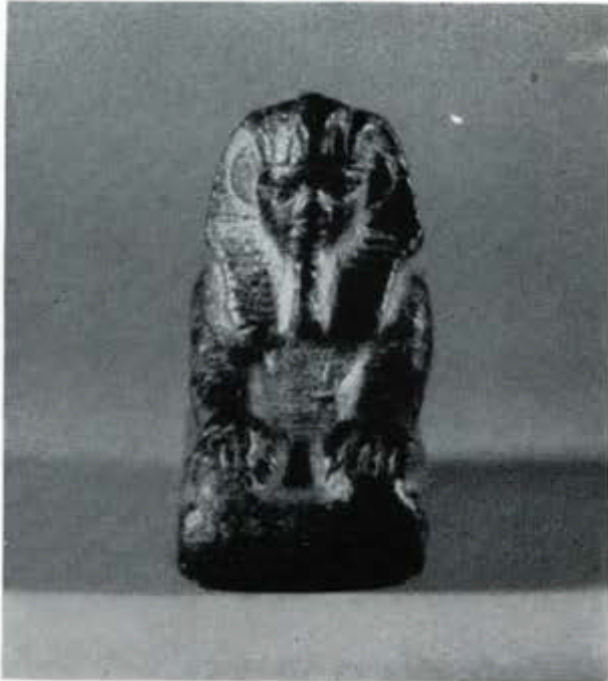
Museum Object Number: 48-16-1
As a result of our acquisition of the figurine and its becoming more generally known thereby, we have been informed of an unpublished bronze statuette of only slightly larger size representing a king similarly clad and in precisely the same position (fig. 16). This piece was excavated only a few years before the purchase of our stone statuette, having been found by the eminent archaeologist George A. Reisner during his work at Der el Ballas, not far north of Luxor. The find subsequently went to the Cairo Museum where it is registered as number 35687 in the museum’s Journal d’Entree. For my knowledge of the bronze statuette’s existence I am indebted to Bernard Bothmer of the Museum of Fine Arts in Boston, who more recently has helped us by identifying our head of Osorkon II. On being shown our stone statuette, Mr. Bothmer recalled having seen something similar among his museum’s excavation records, and shortly thereafter was able to provide the photographs reproduced here, as well as the essential data concerning the piece.
Apart from the difference in material, the two statuettes of a prostrate king are chiefly distinguished by the base on which the king lies. In the case of the bronze figurine this is the lid of a box1 measuring 7.3 cms. in length. A slight projection on either side at one end was designed to keep the lid from sliding too far when it was drawn forward to close the box. As far as this projection the sides are reduced to a thin edge along the bottom to fit a narrow groove. A knob at the other end, almost between the king’s hands, enabled the lid to be tied shut with a cord; around the base of this knob the photographs appear to show a few adherent fibres of the cord used for fastening. On the surface of the lid, to the right of the king, is a phrase giving his name: ” Lives the Good God, Sesostris, given life.” While this one name is not sufficient to identify the bronze statuette as precisely as its steatite counterpart, it probably refers to one of the three kings of that name who belong to the Twelfth Dynasty (reigning between about 1950-1850 B.C.); the face of the statuette, although somewhat worn down, suggests that it is the third Sesostris who is represented. Only one other Sesostris is known, and he belongs to the declining years of the Middle Kingdom, perhaps a century later. The bronze statuette is, therefore, at least three and a half centuries older than the statuette of Amenophis III.
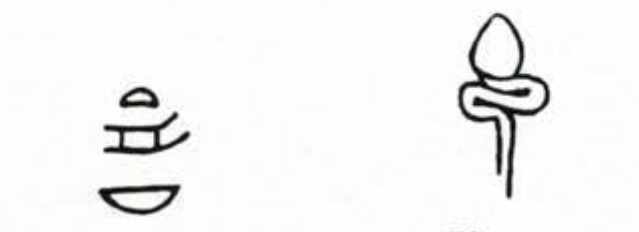
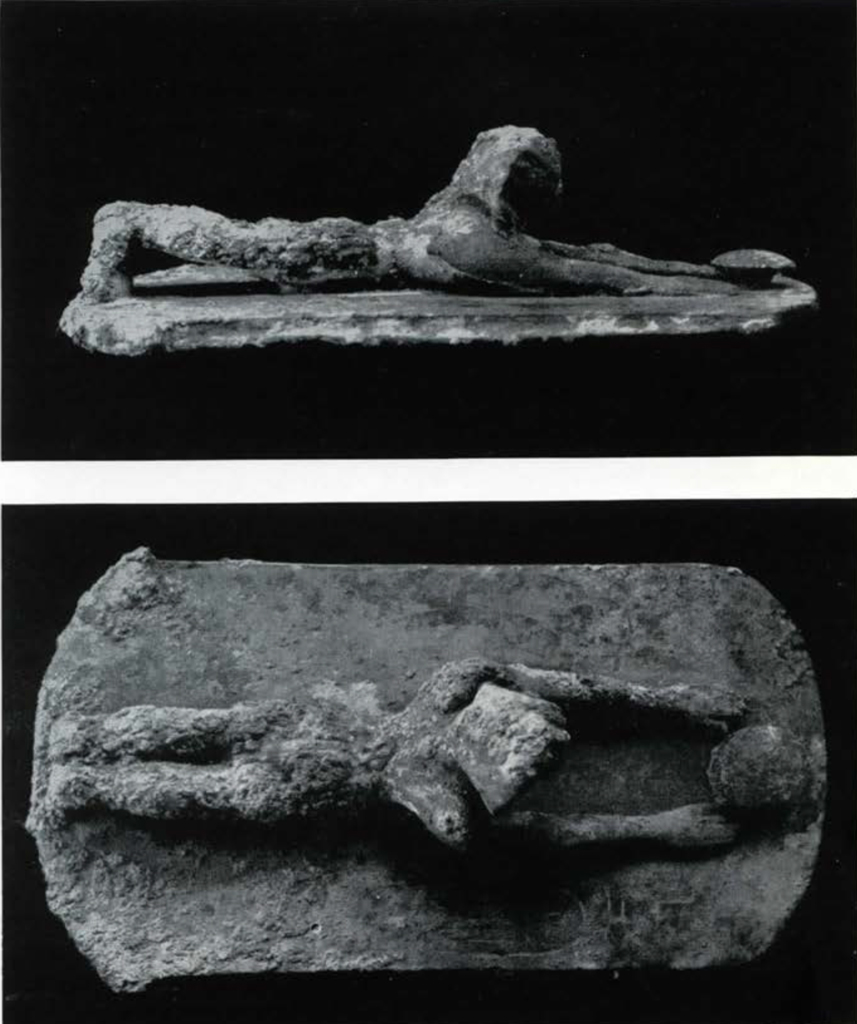
The costume of the king is much the same on both statuettes. In each case he wears the nemes headcloth with the uraeus, the royal cobra, in front and a queue at the back; the details of the uraeus of the steatite figurine are shown in fig. 5. The tight-fitting pleated shendjit kilt is worn by the bronze figure of Sesostris, while Amenophis wears another type of pleated kilt which is stiff and projects forward. The projecting part of the kilt is flattened so that its corners are pushed outward on either side. Amenophis has a ceremonial beard, whereas Sesostris has none, as is often the case during the Middle Kingdom. Both kings are without sandals.
The data assembled above agree with the only possible explanation of the kings’ prostrate attitude: that the statuettes represent these kings in the presence of a god-one might say a superior god-and performing the prescribed obeisances with which the daily ritual begins after the shrine is opened. In theory, only the king could open the shrines containing the divine images in the temples, and give them the ointment, incense, food, and clothing that they required every day. In practice, however, the performance of this ritual was necessarily delegated to priests who served in the many temples throughout Egypt in the king’s stead. The dress that appears on the statuettes is characteristic of scenes in which the king confronts the gods in their innermost shrines.1a The name of “Atum, the Lord (of Heliopolis)” which appears before the figurine of Amenophis I would indicate that he is in the presence of this particular god.


Egyptian texts describing the daily ritual employ various expressions for the obeisance of the king – or his priestly representative – before the gods.2 He “kisses the earth”; he “embraces Geb” (the personification of earth) ; he “places himself on his belly”; he “kisses the earth with (his) head lowered.” This last expression suggests that “kissing the earth,” the most common term for prostrating oneself upon the ground, was not always to be taken quite literally. But there is no doubt that the term essentially means contact with the ground and that it was customary for all Egyptians to express deep respect in this manner, the respect a subject owed his godly king, as well as the respect a king owed to divinities more powerful than himself. To take an early example which illustrates both these points, a Fifth Dynasty tomb inscription (about 2500 B.C.) tells of a monarch’s gratitude to a diligent subject in these words:
Then His Majesty praised him on account of it.
And when His Majesty saw (him) kissing (the earth,
His Majesty said …) “Do not kiss the earth;
kiss my foot.”3
At a later date, soon after the beginning of the Middle Kingdom (about 2000 B.C.) a noble boasts that he was a man
Whose health was inquired after by the great ones with arm bent (in respect), their faces in the earth of Horus of the Two Lands, placing forehead on the ground for him.4
Thus the attitude of subjection and humility with which the king greeted the gods was the same as that assumed by any Egyptian who came before a person of greatly superior rank. The king’s barefootedness is probably another widely practiced token of respect, for a second official of the early Middle Kingdom says: “the great ones entered before me barefoot.”5 The same custom is later observed by an Egyptianized Hebrew who removed his sandals before approaching his god, who spoke from a burning bush.
It may be that the ancient Egyptians felt some reticence about portraying themselves “kissing the earth” in an attitude of complete prostration. A very few cases, involving private individuals, are known from the Fifth Dynasty onward.6 In the New Kingdom, when “kissing the earth” before a god is frequently represented, the subservient figure usually bends as low as is possible from a kneeling position (fig. 18), and then, still upon his knees, he raises his hands in adoration. Much less frequently the body is flattened upon the ground almost as completely as in the case of our two statuettes: King Akhenaton, the Amarna heretic, and his family prostrate themselves before the Aton ( sun disk), but keep their arms bent under them.7 In bending their arms they possibly pay greater rather than less respect to the god.
Although no existing statues representing a prostrate king are known to me apart from the two which are the subject of this article some further examples are known indirectly, as pictured in late reliefs.8 The earliest of these parallels is a pair of statues of Nectanebos II (359-341 B.C.), the last king of the native Egyptian dynasties (fig. 19). The statues are represented in the small-scale reliefs of a shrine, among other statues of the king and of various divinities. A brazier is placed before each of the prostrate statues, on the same base. The arms are bent as described above in the mention of Akhenaton. Among the reliefs of the Edfu Temple, about two centuries later than the foregoing example, there are representations of statuettes which show a prostrate king offering a jar of ointment (fig. 20).

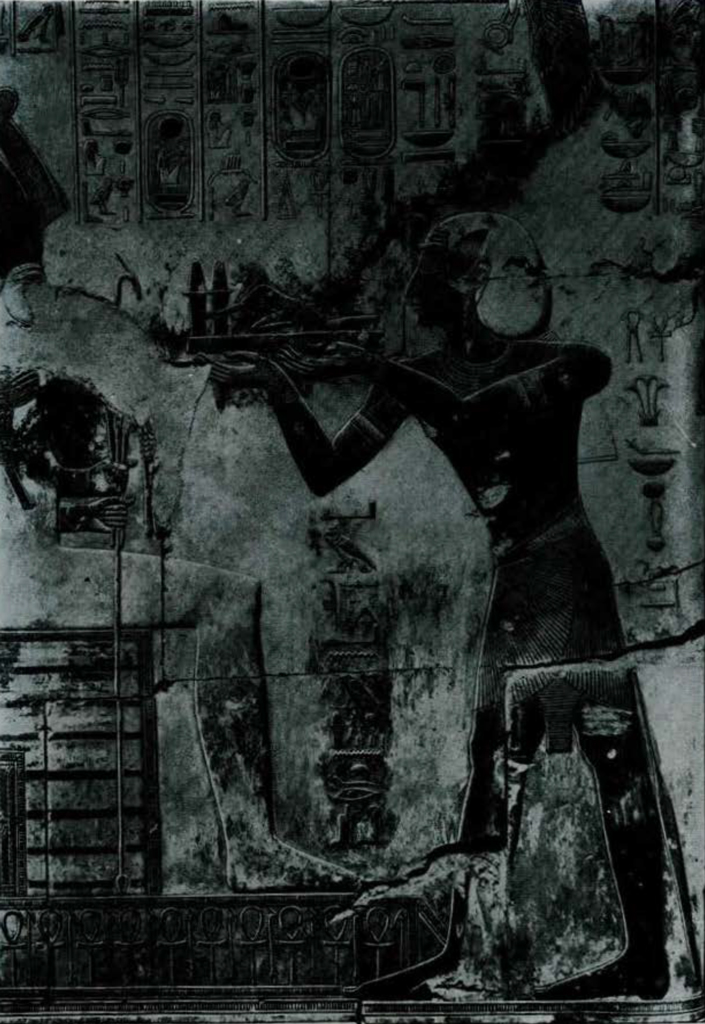
Something can be said about the purpose for which our bronze and steatite statuettes were made. Since the king would have prostrated himself before no one but the gods, we may safely assume, first of all, that these statuettes are intended for use in the temple. In scenes illustrating the temple rituals, it often happens that small statues of somewhat similar character are presented by the king. Fig 22, for example, shows Seti I (1318-1298 B.C.) extending a statuette which, kneeling humbly, in turn extends two jars of perfumed ointment. It is unlikely that the offering of such a statuette spared the king the trouble of kneeling himself. But such statuettes may have served the purpose of bringing the king into the many temples of Egypt to make him, in the hands of his priestly representatives, the active participant that theory prescribed.9
If the Middle Kingdom bronze statuette is considered with this purpose in mind, the next step is to determine whether any ritual object is known to have had a sliding lid. During the Middle Kingdom-and apparently only in this period-one of the most essential ritual objects, the censer, did in fact have a lid of this type. Fig. 24 illustrates such a censer; it is a long armlike object, with a hand at one end supporting the bowl in which the incense is burned.11 The pellets of incense are stored in a box mounted upon the arm at some distance from the bowl. In our illustration a round pellet taken from the partly open box is about to be dropped into the cone of flame and smoke. Censers may well have been surmounted with a figure of the king in early times as were other objects used in the rituals (fig. 21),11 although it is only in the Seventh Century and later that censers with such figures are actually attested (fig. 23).12

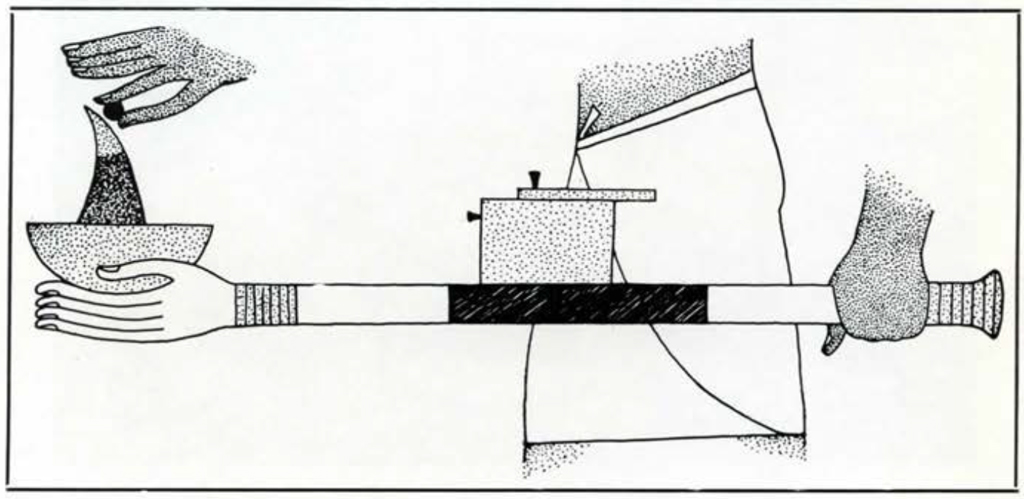
It is much more difficult to find a precise explanation for the use of the New Kingdom steatite statuette. The inscription on the underside suggests that it may have been a seal, but for various reasons this interpretation seems unlikely. In the first place, the areas cut away or worn down at either end of the base would remain unexplained; the wear was evidently produced by contact with something harder than the stone, not by a relatively soft substance such as clay. Furthermore the contemporary seal impressions that have actually been found on jars, doors, and documents are not usually so very oblong as the statuette’s inscription; they are often more distinctive in design and always more boldly and clearly executed.13 And, on the other hand, small figurines which were evidently not intended to be used as seals occasionally have an identifying inscription on the underside of the base if no other surface is available; it is fairly certain that our statuette is to be classed with these.14 A particularly interesting parallel is to be found among the scarab shaped objects which were used as a pendant or bead rather than a seal. The back of this scaraboid (fig. 17) is in the shape of a prostrate human figure with pleated kilt and full wig; his knees are bent under him, his arms are likewise bent and his head, turned sideways, rests on one forearm. The attitude is comparable to that of the man “kissing the earth” in the adjacent fig. 18, though it is to a certain extent adapted to the scaraboid’s oval shape and minute size. The face may be turned to one side to simplify the representation, little detail being required to convey the idea of the head in profile. On the underside of the scaraboid is a design including the much-repeated name of Tuthmosis III; the other examples of this type (there are a good many) do not always contain a royal name, however.15

Museum Object Number: E14350
If our statuette is not a seal, it may have been among the small figures of himself that the king-or his priestly representative-offered to the god. The cut away or worn ends of the base suggest, however, that the statuette was reshaped to fit a curved receptacle of a material harder than itself that produced some additional wear at the ends, but not the bottom, when the statuette was occasionally removed and replaced. Here it should also be recalled that the figure itself is not much worn by handling. These indications do not favor the possibility that the statuette was offered by itself in the course of the rituals, although this may have been its original purpose; rather it seems to have been part of a group of removable figures representing the god Atum and the king before him, such as may have been placed in the temple as a votive offering.16 The very small scale of the statuette also speaks for this conclusion. Since the statuette of the king was apparently placed in a curved depression, it seems possible that the group of figures were arranged not in a flat base, but in a small ceremonial bark, with the curved end of the statuette fitting the rise of the deck towards the prow. While it may seem surprising that a finished statue should be mutilated to fit it into a sacred bark or some other receptacle, we have a parallel for such mutilation in a fine steatite statuette of much larger size (fig. 25). This is a figure of Amon which has the back of each hand chiseled off, evidently with the intention of fitting it into a space which was otherwise slightly too narrow to accommodate it.
It is hoped that this discussion will have brought out the more significant points which may shed light on the meaning and purpose of the prostrate statuettes of Amenophis III and Sesostris. In such cases, however, one must not be overconfident that a tidy explanation is the correct one. There are compensations for such reserve, for it is not the least attractive quality of the University Museum’s acquisition that there remains a certain amount of mystery concerning its use.
NOTES
1 A nail was driven through the back of the figure, projecting beyond the underside of the lid itself for more than a centimeter. Apparently this nail was intended to secure the figure at a point, just in front of the belt, where it had cracked apart. (The head of the nail is visible in fig. 16). Conceivably, however, the nail itself caused the crack. In any case it would have prevented the lid from being drawn more than half open. The statuette is otherwise secured by four rivets: one beneath the feet, one beneath the kilt, and one beneath each hand. A somewhat larger rivet secures the knob. ↪
1a Abubakr, in his Untersuchungen über die ägyptischen Kronen, pp. 67-68, note, that the headcloth is particularly frequent in such scenes; he refers to Calverly, The Temple of King Sethos I at Abydos. The reliefs of this temple also invariably represent the king barefoot before the gods, although on some occasions, at least, the king wore sandals while offering to a god (as often in the volume Medinet Habu IV, by the Chicago Oriental Institute’s Epigraphic Survey). Another contradictory piece of evidence is a brief description of the temple rituals which speaks of “taking (ssp) the white sandals” (Instruction for Merykare, line 64). See further on this question note 5 below. ↪
2 Moret, Le rituel du culte divin journalier en Égypte, pp. 56-66. This ritual is preserved in Berlin Papyrus 3055, which has been dated to Dyn. 22 (850-730 B.C.); see Moller, Hieratische Paläographie III, p. 7. ↪
3 Sethe, Urkunden I, (1933 edition), p. 41, lines 12ff. The transcription is less complete in the first edition of Heft 1. A second Dyn. 5 tomb inscription similarly says of the owner: ”When His Majesty praises him for something, His Majesty causes him to kiss his foot; His Majesty does not let him kiss the ground.” This passage is in Mariette, Mastabas, H 14, p. 451 (British Museum 682). ↪
4 Clère-Vandier, Textes de la Premiere Période Intermêdiare I, no. 32, line 6. The verb dhn (t3) “touch (the earth) with the forehead” his a prostrate figure as a final determinative ↪
5 This inscription of a Middle Kingdom official, the Treasurer Bebi, appears on an unpublished Denderah stela, University Museum 29-66-609. Its date is clearly Dyn. 11, as seen from several palaeographic and orthographic details. The stalement quoted in translation is:

Dg3 “(to be) barefoot” is known otherwise at Denderah (Cairo J. d’E. 46848) and Moalla in a context that leaves no doubt about the meaning. See Vandier, Mo’alla, pp. 220 (IV 6), 223 (f), and Erratum following p. 292. In the most ancient funerary spells, sandals are also removed as a gesture of respect by the gods when they welcome the deceased king; they cast off their clothing and their white sandals (Sethe, Die Altaegyptischen Pyramidentexte II, Pyr, 1197 c.) Although the evidence for the removal of sandals in the rituals is not entirely clear (see above, note 1a), we can at least say that the king did often appear barefoot before the gods, and that he probably did so in deference to them; this token of humility is well suited to the prostrate attitude of the two royal statuettes under discussion.
↪
6 Prostrate figure, representing peoples subject to the king are to be found in the reliefs of Von Bissing, Das Re-Heiligtum des Königs Ne-woser-re, vol. II, pls. 10, 15, 22, 23. Little is left of the inscriptions accompanying these figures, but they may he compared with the much later parallels in Naville, The Fesitval Hall of 0sorkon II, pls. 2, 11, 14, 15, where Egyptian potentates and the foreign chief, ”kiss the earth.” An Old Kingdom example of a semi-prostrate attitude of humility is found in a private tomb where superintendents of estates are shown presenting themselves for the seasonal reckoning (Lepsius, Denkmäler II, pl. 63). ↪
7 Lacau, Stèles du Nouvel Empire, p. 214 and pl. 65 (Cairo Cat. 34175). Pendlebury, City of Akhenaten III, p. 69 and pl. 70 (11). ↪
8 There are a number of New Kingdom statues showing the king in a semi-prostrate position, usually pushing an offering before him. Exmaples are collected and illustrated by H. W. Müller, “Die Torso einer Königstatue,” in Studi Rosellini II, pp. 192 ff., and by Cyril Aldred, “A Statue of King Neferkarē’ Ramesses IX,” Journal of Egyptian Archaeology 41 (1955), pp. 3-8; the name of Sesostris on the base of the bronze Cairo statuette proves the prostrate attitude to have been employed in representations of the king at much earlier date than Aldred supposes. ↪
9 Such statuettes are also occasionally seen in the hands of priests other than the king: e.g., Champollion, Monuments de l’ Égypt, pl. 345 (Temple of Amenophis III, Luxor.) and Mariette, Denderah I, pls. 75-77. ↪
10 The censer illustrated in fig. 24 is found, with another like it, in Newberry, Beni Hasan I, pls. 17, 18; IV, pl. 17 (redrawn here, and slightly restored). Another exmaple appears on the Dyn. 12 stela Cairo Cat. 20559. The drawing of this is Lange-Schäfer, Grab- und Denksteine des Mittlerem Reichs IV, pl. 115 (981) does not show the incense box correctly; it is clearly, with the two knobs represented. ↪
11 The example illustrated in fig. 21 is from a Karnak relief of Tuthmosis III which Schäfer in this Altägyptische Prunkgefässe, p. 32, says he is unable to loacte more exactly; on the same page Schäfer also reproduces a similar vessel from the Eastern Hall of Annals of Tuthmosis III at Karnak. ↪
12 For an example with the name of King AMasis, of Dyn. 26, see Burlington Fine Arts Club, Ancient Egyptian Art, p. 108. The example illustrated in fig. 23 is Hildesheim 2367, from Roeder Aegyptische Bronzewerke, pl. 38a. In paragraph 292 Roeder refers to a number of similar examples. Some of the more accessible illustrations of Ptolemaic reliefs showing such censers in use are: Oriental Institute Epigraphic Survey, Medinet Habu IV, pl. 228d; Lepsius, Denkmäler IV, pls. 162, 532, 546. ↪
13 A large group of seal impressions on jars, documents and mud bricks in published in W. C. Hayes, “Inscriptions from the Palace of Amenhotep III,” Journal of Near Eastern Studies 10 (1951), pp. 35ff., 82ff., 156ff., 231ff. For a somewhat later Dyn. 18 specimen of a king’s name on a door sealing, see Carter-Mace, The Tomb of Tut-ankh-Amen I, pl. 14. ↪
14 The most comparable example known to me is avery small carnelian sphinx bearing the name of Ramses II; this is now in Kestner Museum, Hannover (Bildkatalog 1, 1955, no. 62) and is also illustrated in Petrie, Amulets, pl. 33 (184a), p. 40. Faience pendant figurines of gods are sometimes inscribed only on the underside of the base; e.g., a figurine of Bastet, Mit Rahineh no. 360, found during the University Museum’s excavations of 1955 and soon to be published in the report for that season. In such cases the underside of the base provides the only surface suitable for an inscription of any length. ↪
15 Besides the example illustrated in fig. 17, from Brunton, Gurab, pl. 25 (25)(, I have noted the following: Newberry Scarabs, p. 85, fig. 84; Firth-Gunn, Teti Pyramid Cemeteries, pl. 46 A (42, 46, 67); Randall-Maciver and Wooley, Buhen, pl. 59 (10175; this being the University Museum catalogue number). ↪
16 Statues with smaller figures of the king before them, on a common base, are to be found in Calverly, The Temple of Sethos I, vol. III, pls. 11, 13, 16. For a group of this kind in a bark, see ibid. pl. 64. Numerous small figures of the king are mounted on the ceremonial bark of Horus, for example ibid. vol I, pls. 30, 31) or Amenre (Oriental Institute Epigraphic Survey, Medinet Habu Iv, pl. 230.) ↪
ILLUSTRATIONS PREVIOUSLY PUBLISHED
Fig. 17. See note 15.
Fig. 18. Davies, Rock Tombs of El Amarna I, pl. 13
Fig. 19. Roeder, Naos, pl. 28 (Cairo Cat. 70021)
Fig. 20. H. W. Müller, Studi Rosellini II, pl. 19 (d), reproduced from Chassinat, Edfou 9, Memoires, Mission Archaeologique Francaise au Caire 26, pl. 18.
Fig. 21. Schäfer, Aegyptische Prunkgefässe, fig. 75, p. 32, reproduced from Prisse, Hist. de l’art II, 74.3. See note 11.
Fig. 22. Calverly, The Temple of Sethos I, vol. III, pl. 31.
Fig. 23. See note 12.
Fig. 24. See note 10.
Fig. 25. University Museum Bulletin XV, 2-3, fig. 30 (Univ. Mus. Cat. no. E14350)

